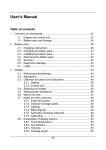Download Product Name
Transcript
Product Name
HCA 400 User Manual
Release AAA-AAC
February 2005
P/N 399Z00007
Business Headquarters
Israel Office
Voltaire, Inc.
6 Fortune Drive, Suite 301
Billerica, MA 01821
Tel: 978-439-5400
Fax: 978-439-5401
www.voltaire.com
Voltaire, Ltd.
9 Hamenofim St.
Bldg. A Herzeliya
46725, Israel
Tel: +972 (9) 971-7666
Fax: +972 (9) 971-7660
Cover Matter
Installation Voltaire HCA 400 and Voltaire HCA 400 host stack software package, which includes all
computer software and associated media and printed materials, and the "online" or electronic
documentation, indicates your acceptance of the terms of the End-User Software License Agreement,
and creates a legal and binding agreement between you (either an individual or an entity) and Voltaire
Inc. For details, please refer to the End-User Software License Agreement.
THIS DOCUMENT IS PROVIDED "AS IS" WITH NO WARRANTIES WHATSOEVER,
INCLUDING ANY WARRANTY OF MERCHANTABILITY, NONINFRINGEMENT, FITNESS
FOR ANY PARTICULAR PURPOSE, OR ANY WARRANTY OTHERWISE ARISING OUT OF
ANY PROPOSAL, SPECIFICATION OR EXAMPLES.
Voltaire disclaims all liability, including liability for infringement of any proprietary rights, relating
to use of information in this specification.
No license, expressed or implied, by written or otherwise, to any intellectual property rights is granted
herein.
This document as well as the software described in it is furnished under license and may only be used
or copied in accordance with the terms of the license. The information in this manual is furnished for
informational use only, is subject to change without notice, and should not be construed as a
commitment by Voltaire. Voltaire Ltd. assumes no responsibility or liability for any errors or
inaccuracies that may appear in this document or any software that may be provided in association
with this document. Except as permitted by such license, no part of this document may be reproduced,
stored in a retrieval system, or transmitted in any form or by any means without the express written
consent of Voltaire Ltd.
Voltaire is a trademark or registered trademark of Voltaire Ltd. or its subsidiaries in the United States
and other countries.
Other names and brands may be claimed as the property of others and have been designated with an
asterisk (*) throughout this document.
Copyright © 2004, Voltaire Ltd.
Voltaire Part Number: [ 399Z00007]
HCA 400 User Manual
ii
P/N 399Z00007 © 2005 Voltaire, Inc.
About this Guide
This User Guide describes how to install and configure the Voltaire HCA 400
on Linux host systems. The HCA 400 consists of an interface card (hardware)
and an InfiniBand host stack (software).
Audience
This guide is intended primarily for system administrators who are responsible
for maintaining and configuring the HCA 400 family.
It is assumed the reader is familiar with InfiniBand technology and terminology.
Document Conventions
NOTE
•
Text set off in this manner presents clarifying information, specific instructions,
commentary, sidelights, or interesting points of information.
IMPORTANT
•
Text set off in this manner indicates presents important information regarding a
specific feature.
CAUTION
•
Text set off in this manner indicates that failure to follow directions could result in
damage to equipment or loss of information.
About this Guide
Document Organization
This User Guide describes how to install and configure the Voltaire HCA 400
on Linux host systems.
•
Chapter 1 – Introduction: Provides a product overview and software
components review.
•
Chapter 2 – Installing the Voltaire InfiniBand Protocol Host Stack:
Describes the HCA 400 installation process, provides an installation Quick
Start, and provides detailed explanations about the installation and preconfiguration instructions.
•
Chapter 3 – Configuring the Host Stack: Describes the host stack
configuration process.
•
Chapter 4 – Protocol Configuration and usage for SDP, MPI and IPoIB:
Describes specific configuration information for the SDP, MPI, and IPoIB
protocols.
•
Chapter 5 – Uninstalling the Host Stack: Describes the procedure for
uninstalling the host stack from a host.
HCA 400 User Manual
ii
P/N 399Z00007 © 2005 Voltaire, Inc.
Contents
Audience...............................................................................................................................i
Document Conventions.......................................................................................................i
Document Organization.....................................................................................................ii
Chapter 1 - Introduction........................................................................................1-1
Product Overview........................................................................................................... 1-2
Host Stack Description .................................................................................................. 1-2
HCA 400 Interface Card Description........................................................................... 1-2
Review of Software Components .................................................................................. 1-3
Chapter 2 - Installing the Voltaire InfiniBand Protocol Host Stack .................2-1
Overview ......................................................................................................................... 2-2
Quick Start...................................................................................................................... 2-2
Host Stack Installation Steps..........................................................................................2-2
Installation Prerequisites for Hardware and Software............................................... 2-3
Required Hardware ........................................................................................................2-3
Required Software .........................................................................................................2-3
Installing the HCA 400 Interface Card........................................................................ 2-4
Host Stack Installation................................................................................................... 2-5
User Authorization.........................................................................................................2-5
Checking the Linux Kernel Version ..............................................................................2-5
Software Installation ......................................................................................................2-6
HPC Installation..........................................................................................................2-6
BIZ Installation...........................................................................................................2-6
Chapter 3 - Configuring the Host Stack...............................................................3-1
Pre-Configuration Instructions..................................................................................... 3-2
Setting Configuration Parameters................................................................................ 3-3
CLI Mode........................................................................................................................ 3-8
Manual Start / Stop........................................................................................................ 3-9
Chapter 4 - Protocol Configuration and usage for SDP, MPI and IPoIB
Protocols ..................................................................................................................4-1
Overview ......................................................................................................................... 4-2
Contents
IP over InfiniBand (IPoIB) Protocol............................................................................. 4-2
Sockets Direct Protocol (SDP) ....................................................................................... 4-3
Utilizing SDP using Current Applications ................................................................. 4-3
Example: Testing FTP over SDP ............................................................................... 4-4
Example: Testing FTP over SDP ............................................................................... 4-4
Server Side:............................................................................................................. 4-4
Client Side: ............................................................................................................. 4-4
Socket Redirect – Configuration File......................................................................... 4-4
Example ..................................................................................................................... 4-6
Using SDP with New Code........................................................................................ 4-6
MPI (Message Passing Interface).................................................................................. 4-7
Compiler Support .......................................................................................................... 4-7
Directory structure and selection................................................................................... 4-7
MPI SDK Content ......................................................................................................... 4-8
Compiling your Application.......................................................................................... 4-8
Running your MPI Application..................................................................................... 4-9
Using mpirun_rsh and mpirun_ssh applications ........................................................ 4-9
System configuration .............................................................................................. 4-9
mpirun_rsh and mpirun_ssh command line options ............................................. 4-10
Host file usage ...................................................................................................... 4-11
Using MPD: ............................................................................................................. 4-11
System configuration ...................................................................................... 4-11
Starting jobs using MPD....................................................................................... 4-12
Using MSTI MPI/PRO Libraries ................................................................................ 4-13
Chapter 5 - Uninstalling the Host Stack...............................................................5-1
Uninstalling the Host Stack ........................................................................................... 5-2
Uninstalling the Host Stack Software ........................................................................... 5-2
Appendix A - Example Configuration.................................................................A-1
Appendix B - Voltaire MPI Memory Consumption and Configuration ..........A-2
Memory Consumption Calculation .............................................................................. A-2
Memory Consumption per Process: .......................................................................... A-2
Memory Configuration................................................................................................. A-3
Example 1 – Running 100 Processes on 100 Nodes using 1 CPU. .............................. A-4
Memory per process: .......................................................................................... A-4
Memory per node: .............................................................................................. A-4
Example 2 – Running 100 Processes on 50 Nodes using 2 CPUs. .............................. A-4
Memory per process: .......................................................................................... A-4
Memory per node: .............................................................................................. A-4
HCA 400 User Manual
ii
P/N 399Z00007 © 2005 Voltaire, Inc.
Figures
Figure 3-1. ib setup Opening Screen ...................................................................................3-3
Figure 3-2. IPoIB.................................................................................................................3-4
Figure 3-3. Fabric ................................................................................................................3-6
Figure 3-4. Firmware-update...............................................................................................3-7
Figure 5-1. Set Up ..............................................................................................................A-1
1
Chapter 1 - Introduction
In This Chapter
This chapter provides introductory and general information on the HCA 400.
The following information is included:
•
Product Overview, on page 1-2.
•
Host Stack Description, on page 1-2.
•
HCA 400 Interface Card Description, on page 1-2.
•
Review of Software Components, on page 1-3.
1-1
HCA 400 User Manual
P/N 399Z00007 © 2005 Voltaire, Inc.
Chapter 1 - Introduction
Product Overview
The HCA 400 enables you to efficiently deploy InfiniBand clusters for High
Performance Computing (HPC) and Business (BIZ) applications.
Organizations around the world have embraced clusters as the most costeffective way to provide superior performance for demanding applications.
Now, high performance InfiniBand technology from Voltaire is enabling these
organizations to significantly improve the performance of their computational
and visualization clusters.
The HCA 400 interface card and the InfiniBand host stack are part of a family
of end-to-end InfiniBand solutions from Voltaire, including the ISR 9024 and
ISR 9288 InfiniBand switch routers, Voltaire IP Router (IPR and RM-4GE) and
Voltaire Fibre-Channel Router (FCR and RM-4FC). Using InfiniBand solutions
from Voltaire, enterprises and high performance computing clusters achieve
higher performance with a lower total cost of ownership.
Host Stack Description
The host stack is a set of device drivers, related binaries, libraries and
documentation, which are installed on Linux host systems.
HCA 400 Interface Card Description
The Voltaire HCA 400 interface card is installed in the host system; and
provides the physical InfiniBand interface.
The HCA 400 is a dual-port, 4x InfiniBand host channel adapter card that
enables PCI-X and PCI-Express based servers to access the full performance of
a high speed InfiniBand fabric. It includes complete software support for a
range of demanding business and HPC applications. The HCA 400 features
Voltaire's TCP/IP emulation software, which enables the InfiniBand fabric to
appear to the server operating system and application programs as a standard
Ethernet network.
The HCA 400 features device drivers for Linux 32 and 64-bit server
architectures and a comprehensive suite of upper layer protocols that are ideal
for high performance computing clusters and high-performance enterprise data
center applications including IBM DB2 and Oracle 10G RAC.
HCA 400 User Manual
1-2
P/N 399Z00007 © 2005 Voltaire, Inc.
Review of Software Components
The HCA 400 is designed to maximize the performance of a 4x (10 Gbps)
InfiniBand fabric. The hardware features remote direct memory access (RDMA)
for high throughput with extremely low CPU utilization and latency. These
capabilities combined with Voltaire's InfiniBand stack allow applications to run
significantly faster achieving bandwidths of over 800 Megabytes/sec, minimal
latency and reduced CPU utilization.
Review of Software Components
The following table lists and describes the main software components relevant
to the HCA 400 and describes the functions they perform. It is recommended
that you review this table prior to installation.
Voltaire Host Stack
Component
Description
HCA drivers
HCA drivers provide the necessary driver
support to control the HCA 400 card.
MPI (Message Passing
Interface)
MPICH is an open-source, portable
implementation of the Message-Passing
Interface standard. It contains a complete
implementation of version 1.1of the MPI
standard and also provides significant parts of
MPI-2, particularly in the area of parallel I/O.
It is based on MPICH-1.2.5 with updates. It
supports local in-memory communication, and
provides support for C and Fortran
applications.
1-3
HCA 400 User Manual
P/N 399Z00007 © 2005 Voltaire, Inc.
Chapter 1 - Introduction
Voltaire Host Stack
Component
Description
SDP (Socket Direct
Protocol)
SDP provides applications with an optional
replacement to TCP, utilizing InfiniBand for
optimal performance and reduced CPU utilization.
IPoIB
IPoIB supports legacy networks on the local
InfiniBand subnet. The standard IPoIB driver model
tunnels standard Ethernet frames across the subnet
using InfiniBand transport services.
IB-ARP
Provides dynamic network address translation.
CM
InfiniBand Communication Manager.
GSI
General Services Interface.
HCA 400 User Manual
1-4
P/N 399Z00007 © 2005 Voltaire, Inc.
2
Chapter 2 - Installing the Voltaire
InfiniBand Protocol Host Stack
In This Chapter
This chapter describes how to install the Voltaire HCA 400 on Linux host
systems. It includes both hardware installation of the HCA 400 interface card
and software installation of the host stack. The following information is
included:
•
Overview, on page 2-2.
•
Quick Start, on page 2-2.
•
Host Stack Installation Steps, on page 2-5.
•
Installation Prerequisites for Hardware and Software, on page 2-3.
•
Installing the HCA 400 Interface Card, on page 2-4.
•
Host Stack Installation, on page 2-5.
•
Pre-Configuration Instructions, on page 3-2.
2-1
HCA 400 User Manual
P/N 399Z00007 © 2005 Voltaire, Inc.
Chapter 2 - Installing the Voltaire InfiniBand Protocol Host Stack
Overview
The HCA 400 host stack requires a working fabric manager to configure the
fabric. As default, the HCA 400 is configured to work with the Voltaire Fabric
Manager (VFM). When working with other vendor subnet managers or with
MiniSM (Mellanox Subnet Manager), make sure that the HCA 400 is
configured to work with the fabric prior to the installation.
NOTE
•
The installation process in the following sections must be completed on each
Linux host that is going to use Voltaire InfiniBand HPC or BIZ Stack software
components.
•
Throughout these installation instructions, the Courier font is used to indicate
messages that the install script prints to the screen. User responses are shown
in Courier.
Quick Start
This chapter provides an overview to the Host Stack installation procedure.
Detailed instructions for relevant installation sequences are described further on
in the manual.
Host Stack Installation Steps
Step 1
Read the Hardware And Software Prerequisites section on page 2-3. Verify that
the host complies with the minimum requirements.
Step 2
Install the operating system in compliance with the requirements stated in
Hardware And Software Prerequisites section on page 2-3.
Step 3
Install the HCA 400 interface card as described on page 2-4.
Step 4
Use the standard RPM utility to install the host stack RPM package version that
matches the operating system and CPU architecture.
Step 5
Configure the host stack as described in on page 3-1.
Step 6
Configure the host stack for one of the following communication protocols (refer
to the Protocol Configuration and usage for SDP, MPI and IPoIB Protocols
chapter on page 4-1):
•
IPoIB
•
SDP
•
MPI
HCA 400 User Manual
2-2
P/N 399Z00007 © 2005 Voltaire, Inc.
Installation Prerequisites for Hardware and Software
Installation Prerequisites for
Hardware and Software
This chapter defines the minimum hardware and software requirements for
Voltaire HCA 400 host system configurations.
Required Hardware
•
Architecture – the HCA 400 supports both 32bits and 64bits architectures:
•
•
•
•
Xeon – i686 architecture
AMD – Opteron – x86_64 architecture
Intel - EM64T – x86_64 architecture
Intel – Itanium2 – IA64 architecture
•
SMP – The HCA 400 supports both symmetric and NUMA multiprocessor
configurations. For optimal performance, using two CPUs or more is
recommended.
•
Bus interface – The HCA 400 comes with either PCI-X or PCI-Express
interfaces. The PCI-X HCA complies with PCI-X2.2 and PCI 2.1 (32/64
bit, 33/66 MHz). The HCA uses 3.3 volts and cannot operate in a 5-volt
slot. For optimal performance, use a PCI-X 133 MHz slot.
The PCI-Express HCA has an 8x PCI-Express interface.
•
Memory – The host stack software requires a minimum of 1024 MB of
RAM.
In large clusters environment the memory requirement might be higher. For
further information please advise Appendix B.
Required Software
The HCA 400 supports the Enterprise additions of Red Hat and Novell
SUSE.Since parts of the host protocol stack and drivers are implemented as
Linux kernel modules, the kernel version used by the host server has a
significant effect on the Host Stack.
For more detailed information on Linux distribution and kernel support please
consult with the HCA 400 release notes.
2-3
HCA 400 User Manual
P/N 399Z00007 © 2005 Voltaire, Inc.
Chapter 2 - Installing the Voltaire InfiniBand Protocol Host Stack
Installing the HCA 400 Interface
Card
Refer to the safety document supplied with the interface card prior to
installation.
To install the HCA 400 Interface Card:
Step 1
Ensure that the host is powered down and disconnect the host from its power
source.
Step 2
Select a free PCI - slot in the host system and install the HCA 400 interface card.
Step 3
Connect the InfiniBand cable to either of the HCA ports and to the switch.
Step 4
Reconnect the host to its power source and power up the system while observing
the card LEDs. If properly installed and operational, one or more of the card
LEDs will light after the system powers up. If no card LEDs appear, troubleshoot
and fix the problem before proceeding (the LEDs will be lit only after the
software installation).
CAUTION
•
The PCI-X channel adapter uses 3.3 volts. Do not attempt to insert it into any 5volt PCI slot. For optimal performance, it is imperative that the channel adapter
be placed in a 133 MHz slot
HCA 400 User Manual
2-4
P/N 399Z00007 © 2005 Voltaire, Inc.
Host Stack Installation
Host Stack Installation
These instructions apply to host stack software components installed on a host
system.
Prior to starting the installation, obtain the host stack installation package from
the Voltaire FTP or web site.
CAUTION
•
At this point you should have the HCA 400 interface card installed on all systems
with the cards connected to the fabric.
•
Prior to installing the host stack software, make sure all InfiniBand drivers from
prior versions are removed (uninstalled) before trying to install the new drivers.
Uninstall information can be found in Chapter 5 of this manual.
User Authorization
An authorized user should perform installation. Please login to the system as
user root.
Checking the Linux Kernel Version
When installing a binary package, compatibility is required between the
software package and the kernel installed on the server.
To check the kernel version, use the uname –r command and make sure that
you are using the correct version from the Voltaire website that holds all the
binaries for different kernels.
On the Voltaire web site you will find all binary RPM installations for the
supported Linux distributions and kernels.
2-5
HCA 400 User Manual
P/N 399Z00007 © 2005 Voltaire, Inc.
Chapter 2 - Installing the Voltaire InfiniBand Protocol Host Stack
Software Installation
Software installation of the host stack is performed using the Red Hat Package
Manager (RPM) utility.
The installation procedure varies, depending on the type of Linux system you
are installing on. Select the RPM package suitable for the installed kernel from
the installation package.
The version convention is:
ibhost-<hpc/biz>-<version number>-<kernel version><architecture>.rpm
The default installation installs the software components in /usr/voltaire.
HPC Installation
rpm -ivh ibhost-hpc-version_number-1{the correct
kernel}.arch.rpm
BIZ Installation
rpm -ivh ibhost-BIZ-version_number-1{the correct
kernel}.arch.rpm
IMPORTANT
•
The HCA 400 installation updates some of the environment settings, to enable
these setting please logout / login to the system.
HCA 400 User Manual
2-6
P/N 399Z00007 © 2005 Voltaire, Inc.
3
Chapter 3 - Configuring the Host
Stack
In This Chapter
This chapter describes the configuration process for the host stack. The
following information is included:
•
Pre-Configuration Instructions, on page 3-2
•
Setting Configuration Parameters, on page 3-2
•
Manual Start/Stop, on page 3-8
3-1
HCA 400 User Manual
P/N 399Z00007 © 2005 Voltaire, Inc.
Chapter 3 - Configuring the Host Stack
Pre-Configuration Instructions
After installing the host stack, the following steps must be done in preparation
to the configuration process:
•
IP Address. The HCA 400 uses the Linux network scripts to configure its
IPoIB network interface. When first installing the stack please configure an
IP address using the IB-setup configuration utility or via the Linux network
scripts ( ifconfig, ifup...). The IPoIB interface can also be configured to use
a dynamic IP address retrieved from a DHCP server as described in section
3-4.
•
Logical Link. Make sure that you have a running Subnet Manager in your
fabric. The Host Stack will not be operational without a logical link. When
a logical link is present, the two LEDS on the HCA 400 interface card
should be lighted (one orange, one green) for the port connected to the
fabric.
•
MiniSM (Mellanox Subnet Manager). If you are using MiniSM to configure
the fabric, make sure that the MiniSM scans the fabric after each host
stop/start.
•
HCA Firmware. In certain cases, upgrading the stack software requires a
firmware upgrade. Refer to the firmware update parameter on page 3-7.
Refer to the release notes to determine whether a firmware update is
needed.
HCA 400 User Manual
3-2
P/N 399Z00007 © 2005 Voltaire, Inc.
Setting Configuration Parameters
Setting Configuration Parameters
Host stack configuration parameters are set using the ib-setup command.
The ib-setup is located in /usr/voltaire/scripts which is added to the
system path for convenient use.
NOTE
•
This section focuses on the interactive mode of ib-setup. In some cases it is
preferable to configure the system in CLI mode (usually when working with
external cluster management tools) .The ib-setup utility supports a CLI-like
configuration for some of the configuration parameters. For more information,
refer to ib-setup CLI mode on
page 3-8.
The Opening screen shows the status of your system, InfiniBand configured
parameters and active parameters.
Figure 3-1. ib-setup Opening Screen
The Opening screen features a menu-based configuration utility with the
following options:
Parameter
1) Auto-Start
Options
YES/NO
Default
Value
YES
Description
Determines whether the
InfiniBand stack will be
started automatically
when the computer boots.
3-3
HCA 400 User Manual
P/N 399Z00007 © 2005 Voltaire, Inc.
Chapter 3 - Configuring the Host Stack
Parameter
2) IPoIB
Options
IP-Addr:
192.168.0.10
Net-mask:
255.255.255.0
Broadcast:
192.168.0.255
MTU: 1500
Default
Value
Description
When you configure the IPoIB for DHCP,
select (1) for ON, or (0) for OFF (see 2a
below for explanation on DHCP).
Assign an IP address, netmask, broadcast
address and MTU for the IPoIB-UD interface.
Each host on the InfiniBand fabric should
have a distinct IP address to access the other
hosts on the fabric using IPoIB-UD tunneling.
The same addresses are used when using SDP.
In the event that you are connected to an IP
subnet using the Voltaire IP gateway, this
netmask should be the same as the netmask on
the IP side and the above IP address should be
in the same subnet.
Note:
The MTU must be identical on all the
interfaces.
Figure 3-2. IPoIB
HCA 400 User Manual
3-4
P/N 399Z00007 © 2005 Voltaire, Inc.
Setting Configuration Parameters
Parameter
2a)DHCP
Description
DHCP support over InfiniBand assumes that you have a DHCP server
in the InfiniBand fabric, or that you can reach it via the Voltaire IP
gateway. The DHCP server should have a listener socket on the IPoIB
interface. The DHCP server should be configured to answer the request
in broadcast mode. If the DHCP server does not answer in broadcast
packets, you can change the network script:
/etc/sysconfig/network-scripts/ifup
To request a broadcast answer, by adding –b to the dhcpd.
To configure the stack to work with DHCP, choose the IPoIB parameter
in ib-setup; the following line appears:
Enter DHCP mode for IPoIB-ud0 [1=on 0=off] [0]:
Enter 1 to configure the stack for DHCP or 0 for static configuration.
The stack adds the following files:
In Red Hat:
/etc/sysconfig/network-scripts/ifcfg-IPoIB
/etc/sysconfig/network-scripts/ifcfg-IPoIB-ud0
In SuSE:
/etc/sysconfig/network/ifcfg-IPoIB-ud0
3-5
HCA 400 User Manual
P/N 399Z00007 © 2005 Voltaire, Inc.
Chapter 3 - Configuring the Host Stack
Parameter
3) Fabric
Options
Default
Value
VFM;
MINISM;
ADVANCED
VFM
Description
There are three options for fabric
management configuration:
VFM – When working with Voltaire
Fabric manager (VFM) this option
should be set. The VFM supports
advanced fabric management services
such as: multicast groups, address
translation services (ATS) and path
queries.
MINISM – Choose this if your SM does
not require joining to a multicast group,
or when you are not using a Voltaire
managed switch.
ADVANCED – For expert users, lets
you configure which fabric services will
be supported.
Figure 3-3. Fabric
HCA 400 User Manual
3-6
P/N 399Z00007 © 2005 Voltaire, Inc.
Setting Configuration Parameters
Parameter
4) Firmware
Update
Options
Default
Value
N/A
Description
When choosing this option, the default file that will be
used is the latest firmware version, which was modified
for compatibility and performance reasons.
Caution: updating the HCA with an inappropriate
firmware version can cause operational problems that
are time-consuming to diagnose and repair. Do not
accept the proposed default firmware version until you
have verified that it is appropriate for your installation.
For more information about the firmware versions
supported, please refer to the release notes.
Figure 3-4. Firmware-update
5) MPI
Depends on the
specific package.
For example on
AMD Opteron
system:
mpi.gcc.mpd
mpi.gcc.rsh
mpi.pathcc.mpd
mpi.pathcc.rsh
mpi.pgcc.mpd
mpi.pgcc.rsh
mpi.gcc.rsh
Each directory is designed to support
different compiler and job initiation
method. The directory name is based
on the following convention:
mpi.compiler-name.job-initationmethod.
Each option, once selected, link the
relevant mpi directory to
/usr/voltaire/mpi Please note that the
selection should be consistent on all
the nodes that are part of the same
job.
3-7
HCA 400 User Manual
P/N 399Z00007 © 2005 Voltaire, Inc.
Chapter 3 - Configuring the Host Stack
Parameter
Options
Default
Value
Description
Figure 5. MPI
6) Start
N/A
Loads the InfiniBand Stack and
removes the IPoIB interface.
7) Stop
N/A
Stops the InfiniBand Stack and
removes the IPoIB interface.
8) Exit
N/A
Exits the ib-setup program.
CLI Mode
When working in a clustered environment, users generally use an external
cluster management tool such as PDSH (Parallel Distributed Shell) or CEXEC.
These utilities can run a specific command on each node of the cluster. To
enable the use of such tools to configure the host stack, the ib-setup utility
supports a subset of configuration options in CLI mode.
The configuration options supported in this mode are:
•
ip—used to configure static IP, for example:
ib-setup --config --ip 192.168.1.10 --netmask
255.255.0.0 --broadcast 192.168.255.255 --mtu 1500
HCA 400 User Manual
3-8
P/N 399Z00007 © 2005 Voltaire, Inc.
Manual Start / Stop
•
network—used to configure an InfiniBand IP address according to
the eth0, using the base network , for example:
ib-setup --config --network 192.168.1.0
•
dhcp—used to configure the stack to use dhcp to retrieve its IP address
from the dhcp server, for example: ib-setup --config --dhcp
•
burn_hca—Upload a new firmware image to the HCA; note that after
the burning procedure is completed, you must shutdown the system.
help /?—Provides help on command usage.
Manual Start / Stop
You can use the ib-setup command to start the host stack, or you can use the
following command line commands.
To enable/start the InfiniBand stack support: ibhost.init start.
To disable/stop the InfiniBand stack support: ibhost.init stop.
3-9
HCA 400 User Manual
P/N 399Z00007 © 2005 Voltaire, Inc.
4
Chapter 4 - Protocol Configuration
and usage for SDP, MPI and IPoIB
Protocols
In This Chapter
This chapter describes the specific configuration process for each of the
protocols supported by the host stack. Some of the supported protocols are at
the user-level while some are at the kernel-level. Each protocol is intended for a
specific application/use as described in this chapter. The following information
is included:
•
Overview, on page 4-2
•
IPoIB Protocol, on page 4-2
•
SDP (Socket Direct Protocol), on page 4-3
•
MPI (Message Passing) Protocol, on page 4-7
4-1
HCA 400 User Manual
P/N 399Z00007 © 2005 Voltaire, Inc.
Chapter 4 - Protocol Configuration and usage for SDP, MPI and IPoIB Protocols
Overview
Voltaire’s HCA 400 enables your applications, such as HTTP and FTP, to
communicate via the InfiniBand fabric in the same way as an Ethernet network
would. This section discusses using the following three protocols:
IPoIB
SDP
MPI
Some of these protocols are at the user-level while some are at the kernel-level.
Each protocol is intended for a specific application/use.
IP over InfiniBand (IPoIB) Protocol
The IP/IB (IP over InfiniBand) software module enables standard TCP/IP
connections over the InfiniBand Fabric. Existing applications currently using
TCP/IP can switch to the IP/IB interface with no modifications.
Login to the system and check your IPoIB IP address (using the ifconfig
command), make sure all IP addresses are unique. If any of the IP-addresses are
the same use the ib-setup utility to modify the IP.
Use the IPoIB-UD interface as any other NIC. Use ping or any other TCP/IP
application to check the connectivity between the InfiniBand hosts.
HCA 400 User Manual
4-2
P/N 399Z00007 © 2005 Voltaire, Inc.
Sockets Direct Protocol (SDP)
Sockets Direct Protocol (SDP)
The Sockets Direct Protocol (SDP) defines a standard wire protocol over
InfiniBand fabric to support stream sockets (SOCK_STREAM) networking
over InfiniBand. SDP utilizes various InfiniBand features (such as remote DMA
(RDMA), memory windows, solicited events etc.) for high-performance zerocopy data transfers.
SDP is implemented as an address family under BSD (Berkeley Software
Distribution) sockets. This design allows the user to keep using the BSD sockets
semantics. To start working with SDP sockets, the user needs to call the
socket() system call using Voltaire’s AF_IBT (declared to be 26) address
family.
There are two easy ways to start working with SDP sockets, either by changing
your application to refer to the SDP directly, or by using the Voltaire socket
switch (see details below).
Voltaire’s SDP implementation supports the AIO (Asynchronous IO) extension.
For more information regarding AIO, refer to:
http://lse.sourceforge.net/io/aio.html
Utilizing SDP using Current Applications
To use SDP with your current applications without changing the application
code, you need to define the environment variable LD_PRELOAD and to
configure the SDP-socket switch configuration file, as shown in the example
below.
While using the bash command interpreter, you can use the following, in order
to run an application with SDP:
LD_PRELOAD=/lib/sock-redirect.so <prog-name>
where <prog-name> is the program you would like to use with SDP.
NOTE
•
When working with 64bit architectures, we provide two copies of sockredirect.so, one for 32-bit applications and the second for 64-bit applications.
The 64bit sock-redirect.so resides at: /lib64/sock-redirect.so
4-3
HCA 400 User Manual
P/N 399Z00007 © 2005 Voltaire, Inc.
Chapter 4 - Protocol Configuration and usage for SDP, MPI and IPoIB Protocols
Example: Testing FTP over SDP
Server Side:
LD_PRELOAD=/lib/sock-redirect.so /etc/init.d/xinetd
Restart
-orLD_PRELOAD=/lib64/sock-redirect.so /etc/init.d/xinetd
Restart
This option applies to the users using the 64-bit (Opteron) option.
Client Side:
LD_PRELOAD=/lib/sock-redirect.so ftp <ip-address>
-orLD_PRELOAD=/lib64/sock-redirect.so ftp <ip-address>
on 64-bit systems
The IP address is the IPoIB-UD interface of the FTP server.
Verify that the FTP server is listening over SDP, using the command:
cat/proc/voltaire/sdp-sockets/ib-socket-netstat
You can also define the LD_PRELOAD environment variable as follows:
export LD_PRELOAD=/lib/sock-redirect.so
and it will apply to all commands invoked from the given bash session.
You can also add this line to the ~/.bashrc file for future sessions.
Socket Redirect – Configuration File
The SDP-sockets-switch configuration file is a text-based file, which is very
sensitive to changes. It is located at /usr/voltaire/config/sock-redirect-config.txt.
It controls the behavior of the following system calls: socket(), bind() and
connect().
In order to provide offloading, you should configure the LD_PRELOAD
variable as described previously on page 4-3.
The format of the file is inflexible and all changes should be done carefully.
HCA 400 User Manual
4-4
P/N 399Z00007 © 2005 Voltaire, Inc.
Sockets Direct Protocol (SDP)
The configuration file consists of four parts; each separated with a description
line. The description lines are critical to the file structure and should not be
removed.
•
ENABLE or DISABLE—Controls the SDP socket offloading (default:
ENABLE); when this line states disable, it means that the server will not
use any offloading options. All connections will be TCP only. If this flag is
set to disable, the rest of the configuration file is ignored. This is applicable
for both the client and the server sides.
•
YES or NO—Replaces all TCP Sockets to SDP (default: YES.) The valid
options are YES/NO. When set to Yes all TCP connections will be replaced
with SDP connections, transparently to the applications. Using this option
means that there will be no more TCP connections from the server. When
set to Yes the rest of the configuration file is meaningless.
When set to NO the logic of replacing TCP sockets with SDP sockets will
be affected by the parameters, which are configured in the remaining parts
of the file. This is applicable for both client and server sides.
# Target IPs—Connects via SDP (default: list of IP addresses
•
When the replace all flag is set to NO, Active TCP connections that
connect to the IP’s in this list will be replaced with SDP connections. That
means each connect system call using an address from this list will be
flagged and the connection will be replaced with an SDP connection.
This is applicable for the client side as it controls the connect() system call.
•
# Listen on SDP—Local ports (default: single port and range example).
When the replace all flag is set to NO, TCP listening sockets (which are
listening on all ports) that appear on the list will be replaced with an SDP
listening socket. You can also enter a port range by typing the - character
to state the port range. This option is applicable for the server side, as it
controls the bind() system call.
•
# Listen on SDP—Local IP addresses. (Default: example IP of the local
IPoIB.)
When the replace all flag is set to NO, TCP listening sockets that are listening
on any IP address from the list will be replaced with SDP sockets.
NOTE
•
Configuring the sock-redirect listeners is invalid if the application is listening on
address any. This option is applicable to the server side as it controls the bind()
system call.
4-5
HCA 400 User Manual
P/N 399Z00007 © 2005 Voltaire, Inc.
Chapter 4 - Protocol Configuration and usage for SDP, MPI and IPoIB Protocols
Example
The following is an example of an SDP configuration file, implementing some
of the operations described previously.
# Voltaire Socket Offloading Switch Configuration file
#
# Enable / Disable SDP socket offloading
ENABLE
# Replace all TCP Sockets to SDP
YES
# Target IPs - Connect via SDP
192.168.0.1
192.168.0.2
192.168.0.3
192.168.0.4
# Listen on SDP - Local ports.
50
5000-7000
# Listen on SDP - Local IPs
192.168.0.22
Using SDP with New Code
New programs (or old ones for which you have source code) may use SDP
sockets directly using the address family AF_IBT, which for now is set to 26
using socket the (2) system call. In such cases there is no need for the
LD_PRELOAD environment variable. All other system calls (e.g. read, write,
select, poll, send, recv, setsockopt) on the file descriptor will behave the same
as with the TCP sockets.
HCA 400 User Manual
4-6
P/N 399Z00007 © 2005 Voltaire, Inc.
MPI (Message Passing Interface)
MPI (Message Passing Interface)
MPI is a library specification for message passing, proposed as a standard by a
broadly based committee of vendors, implementers, and users. It is intended for
distributed computing. Voltaire’s implementation of the MPI protocol allows
seamless passing of messages between MPI and InfiniBand.
Voltaire’s MPI SDK (Software Development Kit) provides the user with all
required libraries, include files, build and execution utilities needed for working
with MPI.
This section describes the content of the SDK, compiler support provided, and
explanations and examples of the MPI usage.
Compiler Support
The Voltaire’s MPI SDK supports several C/Fortran compilers.
For each CPU architecture, the MPI SDK supports and compiles with a
different compiler as described in the list below:
GNU – supported on all systems.
Intel C++/Fortran compiler – For IA32, IA64 and EM64T.
PGI – For AMD Opteron.
PathScale – For AMD Opteron.
Directory structure and selection
The Voltaire MPI SDK consists of several directories- each compatible with a
combination of certain compilers and job initiation method.
Before starting any job, please make sure that you are using the compiler and
job start method of your choice.
Use the ib-setup configuration utility to choose the appropriate directory, as
described in section 3-5.
NOTE
•
Please make sure that the same directory is chosen on all the nodes.
4-7
HCA 400 User Manual
P/N 399Z00007 © 2005 Voltaire, Inc.
Chapter 4 - Protocol Configuration and usage for SDP, MPI and IPoIB Protocols
MPI SDK Content
All parts of the SDK reside under /usr/voltaire/mpi.
•
/usr/voltaire/mpi/bin – all executable binaries reside in this
directory. The executable binaries are either MPI applications, such as
mpi_bandwith or mpi_latency, or utilities used to run and monitor the MPI
applications such as mpirun. Note that the installation adds
/usr/voltaire/mpi/bin to the path variable of your environment.
•
/usr/voltaire/mpi/lib – all of the MPI libraries resides in this
directory.
•
/usr/voltaire/mpi/include – all MPI include files that might be
needed for compilation reside in this directory.
•
/usr/voltaire/mpi/examples – in this directory you will find
example code for simple MPI applications.
IMPORTANT
•
In this section, we refer to the /usr/voltaire/mpi as the active MPI implementation.
Compiling your Application
Voltaire’s MPI SDK contains several scripts that will help you to compile your
MPI application using the precompiled libraries. These include scripts for C
programs as well as Fortran programs. All these scripts are located under the
/usr/voltaire/mpi/bin directory.
There are two ways to compile MPI program with Voltaire’s MPI SDK:
•
Using the HCA 400 provided scripts:
•
mpicc -> for C programs
•
mpicxx -> for C++ programs
•
mpif77 -> for Fortran programs
•
mpif90 -> For Fortran 90 programs
These scripts include all of the necessary libraries and compiler flags.
You can check these scripts’ command line options by running the
command with the –show option (e.g. mpicc –show).
HCA 400 User Manual
4-8
P/N 399Z00007 © 2005 Voltaire, Inc.
MPI (Message Passing Interface)
Using your own compiling environment and scripts:
•
To keep using your own makefiles and compilation scripts you should make
sure your application is linked with the appropriate libraries.
To do that add these flags to the link stage:
-L/usr/voltaire/mpi/lib –lmpich –L/usr/mellanox/lib –l -lmtl_common -lvapi
-lmpga -lpthread
NOTE
•
All MPI headers can be found at:
/usr/voltaire/mpi/include
•
All of the compilation scripts support the following linkage flags:
noshlib – to be linked with static MPI libraries.
shlib - to be linked with shared MPI libraries.
•
When no linkage flag supplied, the default mode is linkage with shared libraries.
Running your MPI Application
The SDK enables running the MPI application in one of two methods:
•
Using either RSH (Remote SHell) or SSH (Secure SHell) by running
mpirun_rsh or mpirun_ssh respectively.
•
Using MPD, a multi-purpose daemon that runs on every node.
Using mpirun_rsh and mpirun_ssh applications
System configuration
To start working with either of these execution utilities, you need to enable the
RSH/SSH on all of your servers. Make sure that the hosts can find one another:
verify that the names of all the hosts in the cluster appear in the etc/hosts files
on all the other hosts in the cluster; or make sure that the NIS/DNS is set
properly.
Make sure that no password is needed to open the RSH/SSH connection
between the servers.
IMPORTANT
4-9
HCA 400 User Manual
P/N 399Z00007 © 2005 Voltaire, Inc.
Chapter 4 - Protocol Configuration and usage for SDP, MPI and IPoIB Protocols
IMPORTANT
•
RSH is limited in connection number in large clusters (usually over 128 nodes);
When for
running
the MPI application
using
/ mpirun_ssh, the user can
these configurations,
use of the
SSHmpirun_rsh
utilities is recommended.
load a configuration parameter file to the host stack, changing its default
parameters. The value of the parameters has an impact on memory consumption
and stack scalability. Refer to Appendix A for further information.
mpirun_rsh and mpirun_ssh command line options
mpirun_ssh / mpirun_rsh are simple applications designed to start MPI jobs on
remote hosts. These applications use the following parameters:
Parameter name:
Explanation:
-np #
Number of processors
hostname1 hostname2 | -hostfile
hostfile
Names of the hosts separated by
space or a hostfile containing
the hostname of the servers this
program should run on.
Application name (optional are
command line parameters for
your application)
The MPI application you are
planning to run
mpirun_ssh –np 2 IB1 IB2 ./mpi_bandwidth 1000 256000
This example runs the mpi_bandwidth executable using mpirun_ssh initiator on
two processors (-np 2) between nodes IB1 and IB2. The mpi_bandwidth
executable requires two command line parameters 1000 and 256000 (which are
the number of iterations and the message size).
A different way to run the same application will be to create a hostfile, which
contains the node names:
--------------------------hostfile--------------------------------IB1
IB2
HCA 400 User Manual
4-10
P/N 399Z00007 © 2005 Voltaire, Inc.
MPI (Message Passing Interface)
--------------------------hostfile--------------------------------And then run the command
mpirun_ssh –np 2 –hostfile ./hostfile ./mpi_bandwidth 1000 256000
NOTE
The hostfile should contain the exact number of hosts you specified with the –np
parameter. If the hostfile contains more hosts than specified with –np , the job will be
started using the first np hosts while the others will be ignored
•
Host file usage
Each line in the hostfile file represents one process to be initiated by the
mpirun_xxx application. If you wish to run more than one process on each node
you should duplicate the hostname lines to indicate the number of processes you
wish to initiate.
Please note that the order of process initiation might have a performance effect.
Example
--------------------------hostfile--------------------------------IB1
IB2
IB1
IB2
--------------------------hostfile---------------------------------
mpirun_ssh –np 4 –hostfile ./hostfile ./xhpl
The above example runs the Linpack benchmark using 4 processors on 2 nodes.
Using MPD:
System configuration
Using the MPD as a job start mechanism requires that the daemons run on all
nodes and have proper access right to other nodes.
To do so please follow these instructions:
4-11
HCA 400 User Manual
P/N 399Z00007 © 2005 Voltaire, Inc.
Chapter 4 - Protocol Configuration and usage for SDP, MPI and IPoIB Protocols
1. Create two files called .mpd.conf and .mpdpasswd Theses files could
be a simple one line file that holds your mpd password.
For example:
password=123456
Please note that your MPD password should not be your Linux user
password, but an arbitery password to be used to control MPD access
only.
2. Place these files on all nodes in the user home directory.
3. Set protection on the file so that you have read and write privileges:
chmod 600 .mpd.conf
chmod 600 .mpdpasswd
4. Make sure that the active MPI directory on all nodes is
mpi.compiler.mpd. For detailed instruction please refer to section 3-5
of this manual.
5. Before starting the MPD you need to create a host file that contains the
names of all the nodes which participate in the job.
To start the MPD daemons use the following command line on one of
the nodes:
mvapich.mpd.sh start hostfile /usr/voltaire/mpi/bin
6. If you choose to terminate the MPD daemons you can do so by running
the following command line:
mvapich.mpd.sh stop hostfile /usr/voltaire/mpi/bin
It is recommended to verify that all daemons had exited properly. To
do so please run ./mpdcleanup on all nodes.
Starting jobs using MPD
To start an MPI job using MPD, you need to use a simple application called
mpirun_mpd.
The command line options of mpirun_mpd are similar to mpirun_ssh.
The following command line is a simple example of running mpi_bandwith with 2
processors on 2 nodes using the MPD:
mpirun_mpd -np 2 ./mpi_bandwidth 1000 100000.
HCA 400 User Manual
4-12
P/N 399Z00007 © 2005 Voltaire, Inc.
MPI (Message Passing Interface)
Using MSTI MPI/PRO Libraries
As mentioned in the previous section, Voltaire’s MPI libraries are installed at
/usr/voltaire/mpi. The host stack installation adds this directory to the path. To
use MSTI MPI/PRO libraries you must remove the Voltaire directory from the
Path. Contact MSTI for further information.
NOTE
•
On some Linux distributions there might be other MPI packages installed for
Ethernet connectivity. To verify which MPI packages have been installed, use
the mpirun command. To check the specific package name installed, use for
example, the rpm –qf /usr/bin/mpirun command.
In order to eliminate any confusion, perform one the following:
•
Remove the package that might interfere with the Voltaire MPI. For
example: rpm –e package-name.
•
Include the /usr/voltaire/mpi/bin in you PATH variable before other MPI
directories. For example:
•
for bash users: export PATH=/usr/voltaire/mpi/bin:$PATH
•
for tcsh users: set path=(/usr/voltaire/mpi/bin $path)
4-13
HCA 400 User Manual
P/N 399Z00007 © 2005 Voltaire, Inc.
5
Chapter 5 - Uninstalling
Uninstalling the Host
Stack
In This Chapter
This chapter describes the procedure for uninstalling the host stack from host
systems. It includes the following information:
•
Uninstalling the Host Stack, on page 5-2
•
Uninstalling the Host Stack software, on page 5-2
5-1
HCA 400 User Manual
P/N 399Z00007 © 2005 Voltaire, Inc.
Chapter 5 - Uninstalling the Host Stack
Uninstalling the Host Stack
This section describes how to uninstall the following InfiniBand components:
Host Stack software using the Linux installer (Refer to page 2-5).
•
Uninstalling the Host Stack Software
CAUTION
•
Current configuration will be removed.
Do the following:
ibhost.init stop
To query the installed package run the following command:
rpm –qa | grep ibhost
Use the result package name at the next command:
rpm –e {ibhost package installed}
rm –rf /usr/mellanox
/usr/voltaire
/usr/mst
HCA 400 User Manual
5-2
P/N 399Z00007 © 2005 Voltaire, Inc.
A
Appendix A - Example Configuration
This Appendix provides a brief explanation how to connect and configure a
two-node InfiniBand fabric.
Figure 5-1 shows a simple example of Machine A and Machine B connected via
the InfiniBand fabric.
Figure 5-1. Set Up
The host stack comes with default configuration for the IPoIB interface with the
192.168.0.10 IP address.
For this example setup, reconfigure Server B IPoIB interface IP address, refer to
page 3-3 of this manual , for a description on how to configure the IPoIB
interface.
There is no need to run the Subnet-Manager on the host as it is part of the
Voltaire InfiniBand switch.
NOTES
•
Connect HCA Port #1, which is located farthest from the PCI connector, to the
switch.
•
Machine A and B will get their LID from the Subnet Manager, which is running
on the InfiniBand switch.
•
Each host has ipoib0 NIC interface.
A-1
HCA 400 User Manual
P/N 399Z00007 © 2005 Voltaire, Inc.
Appendix B - Voltaire MPI Memory Consumption and Configuration
Appendix B - Voltaire MPI Memory
Consumption and Configuration
The Voltaire MPI implementation takes advantage of Infiniband RDMA
technology.
Using the IB driver requires pre-allocated buffers to be allocated, mapped to the
HCA, and pinned down in the RAM.
These buffers are required for both regular DMA and Remote Data Memory
Access (RDMA) operations. These buffers are allocated during the job
initialization process.
In general - when running an MPI job over InfiniBand the memory
consumption of the system can be divided to three parts:
•
System memory – Memory used by the OS.
•
MPI pre-allocated memory
•
Application memory that has been pinned down for RDMA purposes.
The following section describes the different components that affect the MPI
pre-allocated memory size. We will suggest a simple formula to help you
calculate the expected memory consumption based on to the cluster size and the
number of processes you are going to use. We will also suggest some
parameters that users can change to reduce the memory consumption.
Memory Consumption Calculation
The Voltaire MPI uses the Infiniband Reliable Connection (RC) mechanism for
inter process communication. A reliable connection is established between
every pair or processes residing on different nodes. Each RC connection uses a
different set of buffers for DMA and RDMA operations.
Therefore the memory consumption of each process is a product of the number
of its peer processes multiplied by resources required for each connection.
Memory Consumption per Process:
((VIADEV_PREPOST_DEPTH+10) * sizeof(VBUF) * (NP-1)) +
(VIADEV_NUM_RDMA_BUFFER * 2 * sizeof(VBUF) * (NP-1)) +
(sizeof(QP) * (NP-1))) + sizeof (CQ).
Where:
•
NP – is the number of processes that participate in the Job.
HCA 400 User Manual
A-2
P/N 399Z00007 © 2005 Voltaire, Inc.
Uninstalling the Host Stack Software
•
VIADEV_PREPOST_DEPTH – represents the number of buffers
posted to the receive queue. Default value is 64.
•
VIADEV_NUM_RDMA_BUFFER – represent the number of preallocated RDMA buffers, these buffers are used in the fast data path.
Default value is 32.
•
Size of VBUF – The size of each pre-allocated buffer. Default value is
12KB.
•
Size of QP – The size of the IB queue pair. Default value around
176KB.
•
Size of CQ – The size of the IB completion queue. Default value around
2052 KB.
Memory consumption on a node is a product of the number of process on the node times the
memory consumption per host.
When working with more than one process per node the MPI will use shared memory for
intra-node communication up to eager size threshold. The size of the shared memory is
being affected by the number of process running on the same node and can be tuned with
parameter file variable: SMPI_LENGTH_QUEUE
IMPORTANT
•
The above description is valid for the MPI initialization allocation, during run time
the MPI would pin down the application memory. This is required to support
RDMA operation. The amount of memory consumed at run time is entirely
depended on the application.
Memory Configuration
It is possible to limit the memory consumption of the MPI by changing the
parameters described in the calculation above.
It is important to understand that changing these parameters could have an
effect on the performance. The influence on performance is highly related to the
application behavior and can not be described in a general way.
Most of the parameters can be changed in runtime using the mpi parameter file.
The parameter file is a simple text file that holds a list of parameters and values
in the following format:
PARAMETER = Value
To use the parameter file, you need to supply it in the mpirun_rsh command
line.
A-3
HCA 400 User Manual
P/N 399Z00007 © 2005 Voltaire, Inc.
Appendix B - Voltaire MPI Memory Consumption and Configuration
Example:
mpirun_ssh -paramfile ./paramfile –np 4 –hostfile ./hostfile ./xhpl
All of the parameters described above, besides the size of VBUF can be
controlled via the parameter file. However we do not recommend changing the
QP and CQ size. Changing these parameters requires deep understanding of IB
mechanisms and should be done by an advanced user only.
The VBUF size can only be changed at compilation time.
Example 1 – Running 100 Processes on
100 Nodes using 1 CPU.
Memory per process:
((VIADEV_PREPOST_DEPTH+10) * sizeof(VBUF) * (NP-1)) +
(VIADEV_NUM_RDMA_BUFFER * 2 * sizeof(VBUF) * (NP-1)) +
(sizeof(QP) * (NP-1))) + sizeof (CQ) =
(( 64 + 10 ) * 12 * 99 ) + ( 32 * 2 * 12 * 99 ) + ( 176 * 99) + 2052 =
87912 + 76032 + 17424 + 2052 = 183418 KB = ~185 MB.
Memory per node:
Since we are running 1 process on the node, the Memory consumption of the
node is similar to the memory consumption of the process ~185 MB.
Example 2 – Running 100 Processes on 50
Nodes using 2 CPUs.
Memory per process:
((VIADEV_PREPOST_DEPTH+10) * sizeof(VBUF) * (NP-1)) +
(VIADEV_NUM_RDMA_BUFFER * 2 * sizeof(VBUF) * (NP-1)) +
(sizeof(QP) * (NP-1))) + sizeof (CQ) =
(( 64 + 10 ) * 12 * 99 ) + ( 32 * 2 * 12 * 99 ) + ( 176 * 99) + 2052 =
87912 + 76032 + 17424 + 2052 = 183418 KB = ~185 MB.
Memory per node:
Memory consumption of the node consists of the number of processes that run
on the node multiplied by the memory consumption of each process.
HCA 400 User Manual
A-4
P/N 399Z00007 © 2005 Voltaire, Inc.
Uninstalling the Host Stack Software
Memory consumption on the node is: 185 * 2 = ~270.
A-5
HCA 400 User Manual
P/N 399Z00007 © 2005 Voltaire, Inc.
Glossary
ACPI
Advanced Configuration and Power Control
AIO
Asynchronous IO
ARP
Address Resolution Protocol
BSD
Berkeley Software Distribution
CLI
Command Line Interface
CPU
Central Processing Unit
FTP
File Transfer Protocol
FW
Firmware
GE
Gigabit Ethernet
GUI
Graphical User Interface
GUID
Global Unique ID
HCA
Host Control Adaptor
HPC
High Performance Computer
IB
InfiniBand
IBTA
InfiniBand Trade Association
IP
Internet Protocol
ISR
InfiniBand Switch Router
LID
Local ID
LIDSTAT
Properties retrieved from a specific LID
i
HCA 400 User Manual
P/N 399Z00007 © 2005 Voltaire, Inc.
Glossary
LAN
Local Area Network
LMC
LID Mask Control
PDSH
Parallel Distribute Shell
RPM
Red Hat Package Manager
RSH
Remote Shell
SDP
Socket Direct Protocol
SDK
Software Development Kit
SSH
Secure Shell
SM
Subnet Manager
SWG
Software Working Group
TCP
Transmission Control Protocol
UDP
User Datagram Protocol
HCA 400 User Manual
ii
P/N 399Z00007 © 2005 Voltaire, Inc.
Index
4
4x InfiniBand host channel adapter, 1-2
Host Stack, 1-2
Host Stack Component, 1-3
Host Stack Installation, 2-6
HPC, 1-2
B
I
Before you Start, 2-2
BIZ, 1-2
C
CM, 1-4
Configuring the InfiniBand Stack, 3-1
CPU utilization, 1-3
Current applications, 4-3
D
Document Conventions, i
Document Organization, ii
E
Emulation Software, 1-2
Ethernet, 1-2
Example, 4-6
IB-ARP, 1-4
InfiniBand-Stack Configuration for SDP,
MPI and IPoIB Protocols, 4-1
Installation Prerequisites, 2-4
Installation Steps, 2-3
Installing the Voltaire InfiniBand
Protocol Host Stack, 2-1
Introduction, 1-1
IPoIB, 1-4
IPoIB Protocol, 4-2
M
Manual Start / Stop, 3-7
Mellanox Subnet Manager, 2-2
MiniSM, 2-2
MPI, 1-3, 4-6
P
F
FC Routers, 1-2
FCR 400 InfiniBand, 1-2
G
GNU C/FORTRAN, 4-6
GSI, 1-4
PCI-X card, 4-2
Pre-Configuration, 2-7
Preparing the stack, 3-1
Product Overview, 1-2
Q
Quick Start, 2-2
H
HCA 400 features, 1-2
HCA 400 Interface Card, 1-2
HCA drivers, 1-3
R
Required Hardware, 2-4
Required Software, 2-4
i
HCA 400 User Manual
P/N 399Z00007 © 2005 Voltaire, Inc.
Index
RM-2GE, 1-2
RM-4FC, 1-2
U
Uninstalling the Host Stack, 5-1
Using SDP with new code, 4-5
S
SDP, 1-4, 4-2
Software Components, 1-3
V
Voltaire Fabric Manager, 2-2
T
Two InfiniBand-Hosts connected
through InfiniBand switch using
InfiniBand Fabric, A-1
HCA 400 User Manual
ii
P/N 399Z00007 © 2005 Voltaire, Inc.




































































